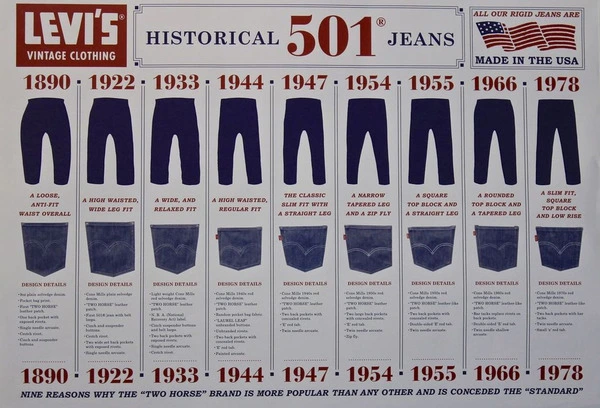Why Do the Years Matter?
For true vintage denim collectors, there's no brand more significant than Levi's Vintage Clothing (LVC). Since 1996, this sub-brand was established by Levi Strauss & Co. to reproduce their classic vintage denim styles as authentically as possible. Over the years, LVC has created numerous models of the iconic 501, each marked with a specific year. This isn't just a random number—it's a historical record of significant design changes that tell the story of how a simple pair of work pants evolved into an American cultural icon.
The Pioneering Era and Early Beginnings (Late 19th - Early 20th Century)
-
LVC 1873: This is the birth year of the world's first denim jeans, featuring the characteristic indigo-dyed denim and metal rivets for reinforcement. It was a revolutionary piece of clothing for the working class.
-
LVC 1886: This year marks the first time that Levi's jeans featured the "Two Horse Pull" logo on the back leather patch, a powerful symbol of the jeans' durability that continues to this day.
-
LVC 1890: A crucial year, as this is when the jeans were officially designated with the lot number 501 to distinguish them from other products.
-
LVC 1901: After years of having just one back pocket, this model was the first to feature two, making it closer to the 501 design we know today.
-
LVC 1915: This year commemorates a major collaboration between Levi's and the Cone Mills denim factory, which became their exclusive fabric supplier for decades.
The Era of Adaptation and Change (1930s - 1940s)
-
LVC 1933: This was the last model to feature suspender buttons around the waist and to use exposed rivets on the back pockets before they were replaced by a new, hidden style.
-
LVC 1937: This year is significant for the introduction of the iconic Red Tab on the right back pocket, a new feature to combat counterfeits. It was also the last model to have a cinch-back belt.
-
LVC 1944: This unique model was produced during World War II, and its design reflects the wartime fabric and thread rationing. For instance, the back pocket arches were painted on instead of stitched, making it a truly special, one-of-a-kind reproduction.
The Golden Age of Denim (Post-WWII - 1970s)
-
LVC 1947: One of the most popular models among collectors. This design returned to full production after the war and was the first to feature the diamond point intersection on the back pocket stitching.
-
LVC 1954: This model marked a major turning point, as it was the first 501 to use a zipper fly instead of the traditional button fly, catering to a growing demand for convenience.
-
LVC 1955: This model transitioned from the classic leather patch to a new cardboard "gasket" patch on the back waist, which also became a popular feature.
-
LVC 1966: For this model, Levi's replaced the back pocket rivets with black bar-tack stitching, giving the pockets a cleaner, more streamlined look.
-
LVC 1976: This was the last model to use ring-spun denim, giving the fabric a distinct texture and fade. It was also the last to feature single-needle stitching on the back pocket edges.
The Final Chapter of Selvedge
-
LVC 1984: This model is notable as it was the last LVC to be made with selvedge denim, marking the end of an era before the textile industry shifted to modern, high-speed looms. It’s also known for its unique sandy texture.
As you can see, the journey of each 501 LVC model year tells a story of evolution. From minor tweaks to major overhauls, these changes reflect the fashion trends and practical needs of their time. That's why owning a pair of LVC jeans isn't just about buying a new pair of pants—it's about owning a tangible piece of history.








